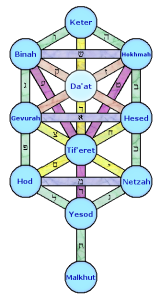
Who were Adam and Eve? What were they? Were they Homo sapiens?
Genesis seems to describe them as human, yet God tells Adam that he will surely die on the day he eats from the tree of the fruit of knowledge of good and evil. And Adam lives for 930 years, according to Genesis 5. If Adam and Eve did not have children in the Garden, then Cain, Abel and Seth would have been born after their parents had been expelled. Seth was born when Adam was 130 years old, so Adam lived at least 800 years after he left the Garden. So, what died on the day he ate the fruit?
The consensus seems to be that Adam died spiritually. So was Eden only a spiritual garden? Was Adam only in spiritual form?
These are the types of concerns to be addressed by this website, though this is only the starting point. Where this discussion leads us is limited only by imagination and a thirst for understanding, but if you comment, please keep the discussion within the scope of the title.
Adam and Eve, Spirit or Flesh?
In the Garden, Adam and Eve were in spirit form only. All of the descriptions of physicality were metaphor only.
That’s my current take on Genesis. Why do I think this?
First of all, God tells Adam that he would die on the day he ate of the tree of knowledge of good and evil. But both Adam and Eve did not literally, physically die on that day. Both were escorted out of the Garden and Adam, according to Genesis 5, lived to the ripe old age of 930.
So, in the Garden, Adam and Eve were the individuals created in Genesis 1:26—created in the image and likeness of God. In other words, they were non-physical, spiritual and potentially immortal sources of creation. Essentially, this makes them baby gods or angels. Jesus, in the New Testament, reinforces this notion when he reminds his enemies of what is written in their Law—that “ye are gods” (John 10:34). Christ’s reference to Psalm 82:6-7 seems to go beyond the use of this label to mere magistrates. After all, his enemies were about to stone him for blasphemy. They had misunderstood his claim that he and the Father were one to be a claim of being God Himself. But the oneness of which Jesus spoke was the harmony of purpose that only faith can carry. The magistrates of Psalms had abused their power and yet were still called “gods.”
Some of my friends refuse to believe that we are baby gods. Perhaps it is their humility. And that is a good thing. Those without humility would abuse their abilities if they had the chance, but humility is required to develop them. Spiritual maturity requires humility. But our mandate is to use those abilities and to become more and more like God. As we do this, we move closer and closer to Him. Christ repeated the idea that the miracles attributed to him were really the faith of the individuals who received the gift. This is what Adam and Eve gave up when they left the Garden.
Both of the trees mentioned were also spiritual and not physical. To the Jewish group, Kabbalists, the “Tree of Life” is a conceptual matrix of nodes (Sephirot). The “female” half of this tree descends from God (“crown”) and the “male” half ascends back toward God. These nodes have meanings like “wisdom,” “understanding,” “kindness,” “beauty,” “foundation” and others.
So, what of the other tree—the one bearing the forbidden fruit? This is covered in more detail in the “Forbidden Fruit” article. But quite simply, this one is also non-physical consisting of dichotomies like good-evil, right-wrong, generous-selfish, compassion-indifference, confidence-doubt and many others.
If Adam and Eve were spirit in the Garden, then they seemed to have been very physical on Earth. Genesis 5:2 gives us an unexpected perspective. Here it tells us that Adam is a group of both male and female. Thus Adam in Genesis 5 seems to be not only an individual, but an eponymous tribe, too. Could Adam in the Garden have been all of us, spiritually? Half of us?
What are your thoughts on this?
Rod Martin, Jr.
The Bible’s Hidden Wisdom
This article was originally published 2012:1212 on GenesisCode.net forum.






